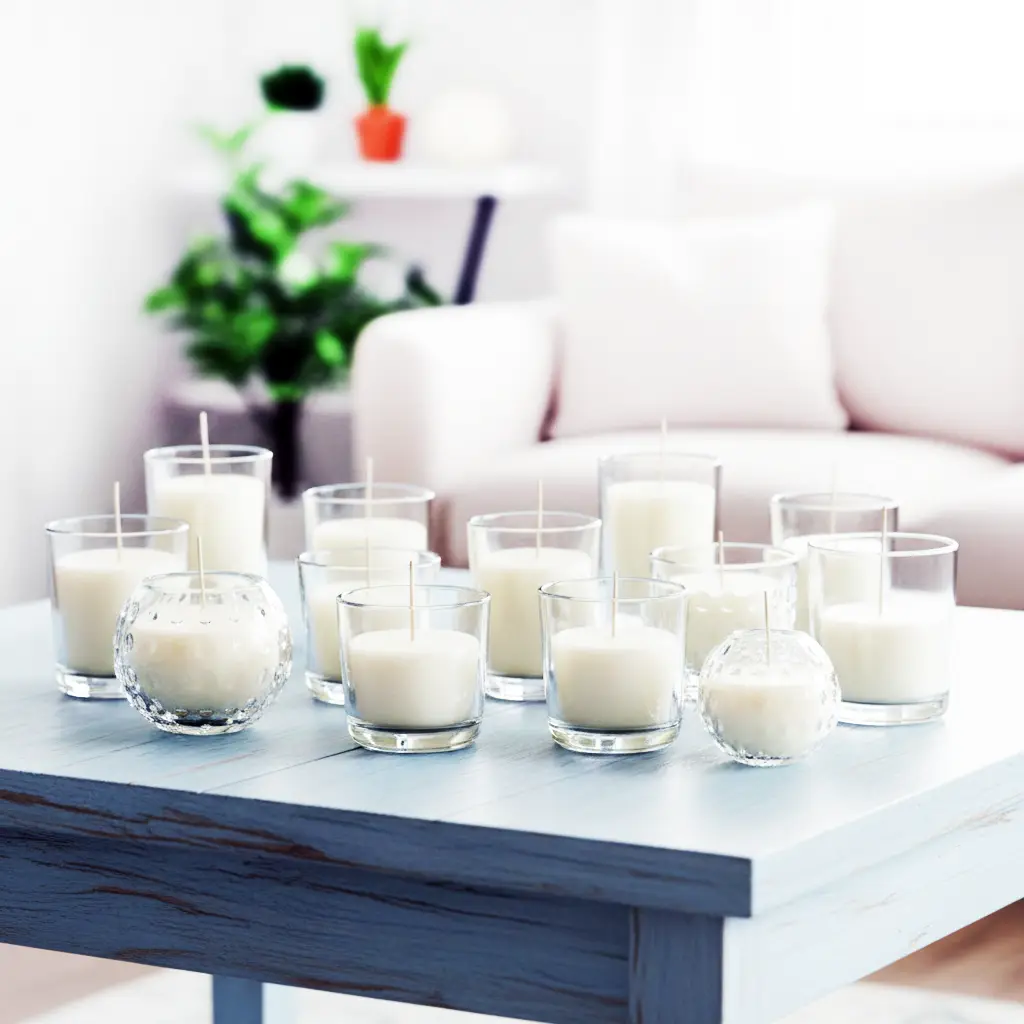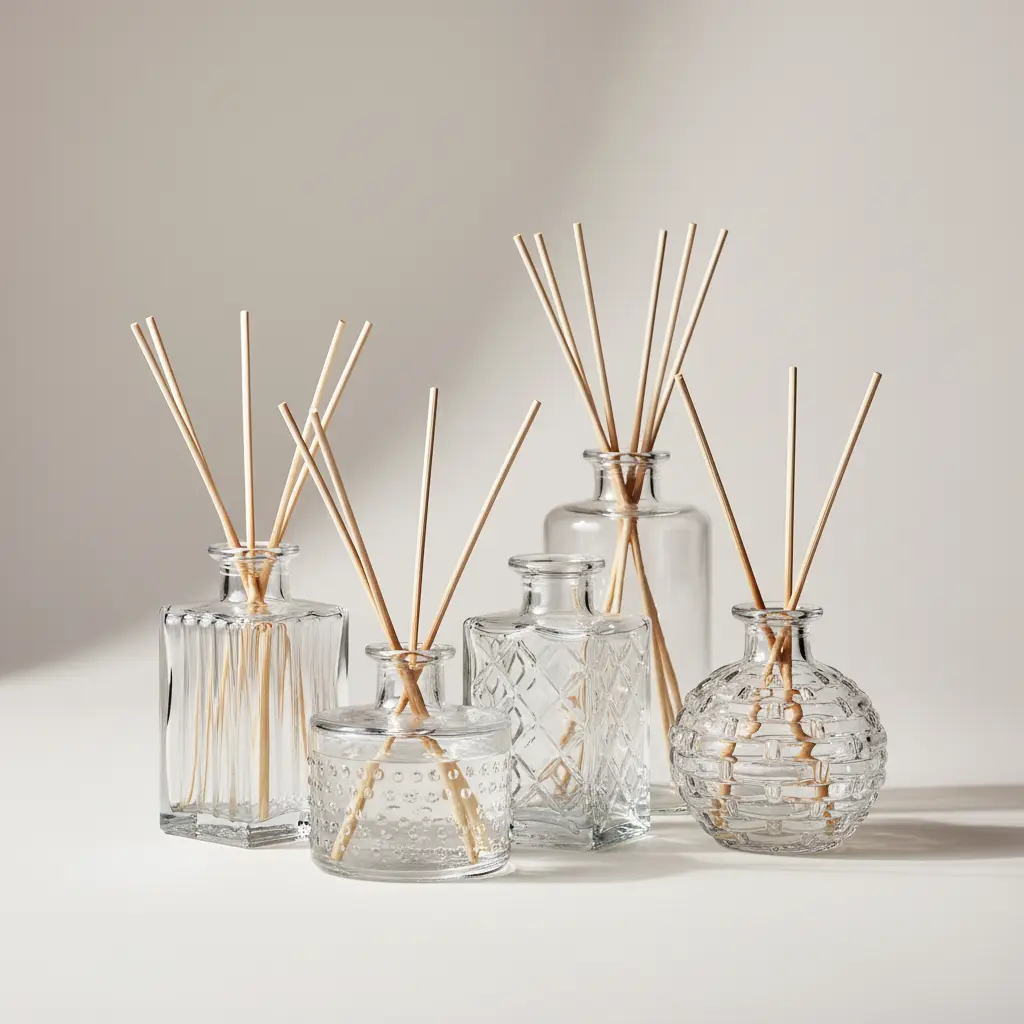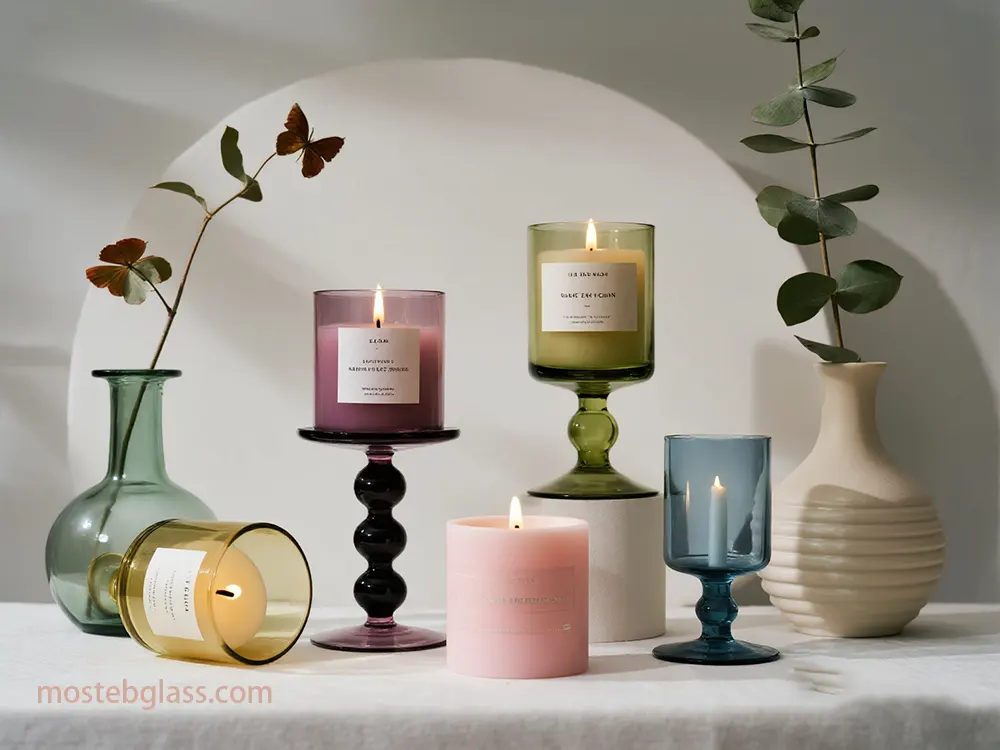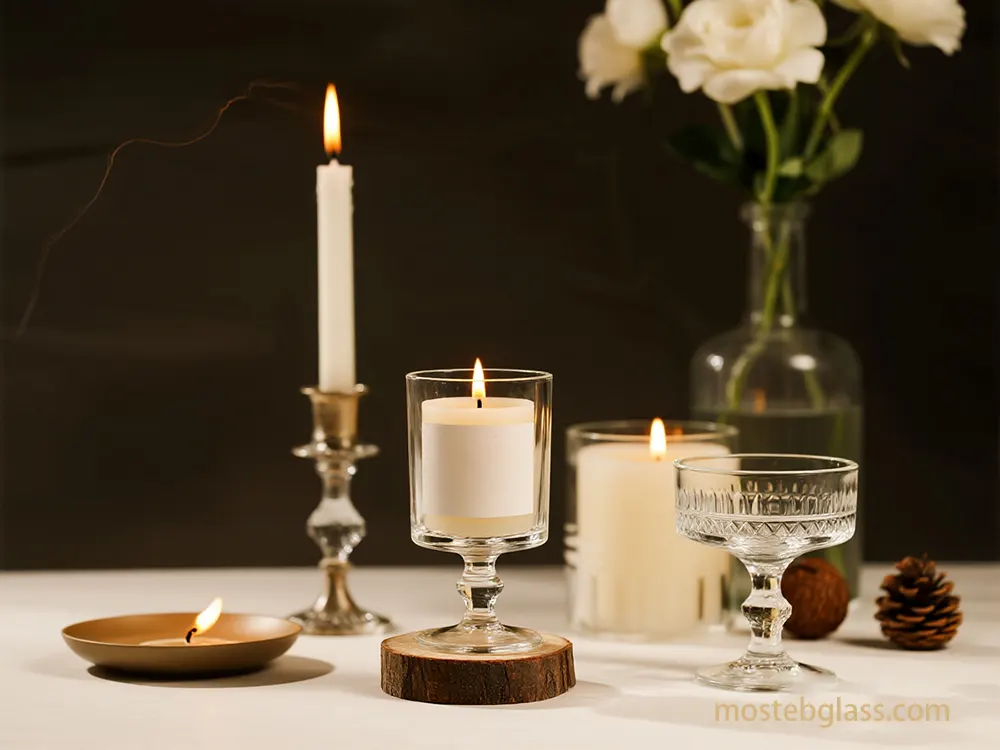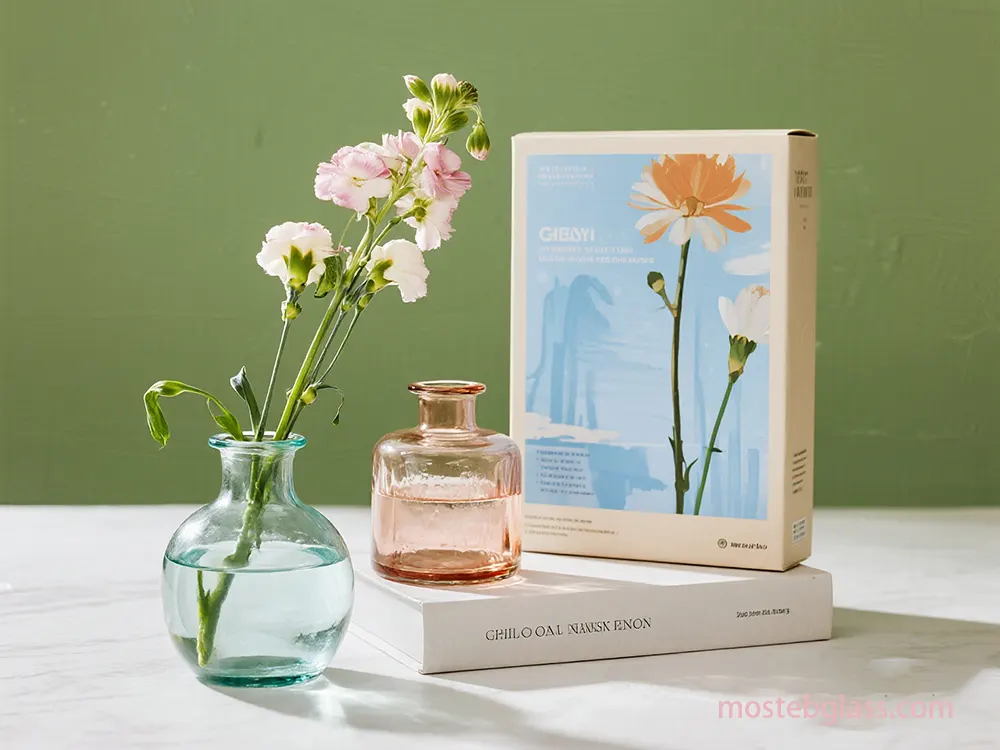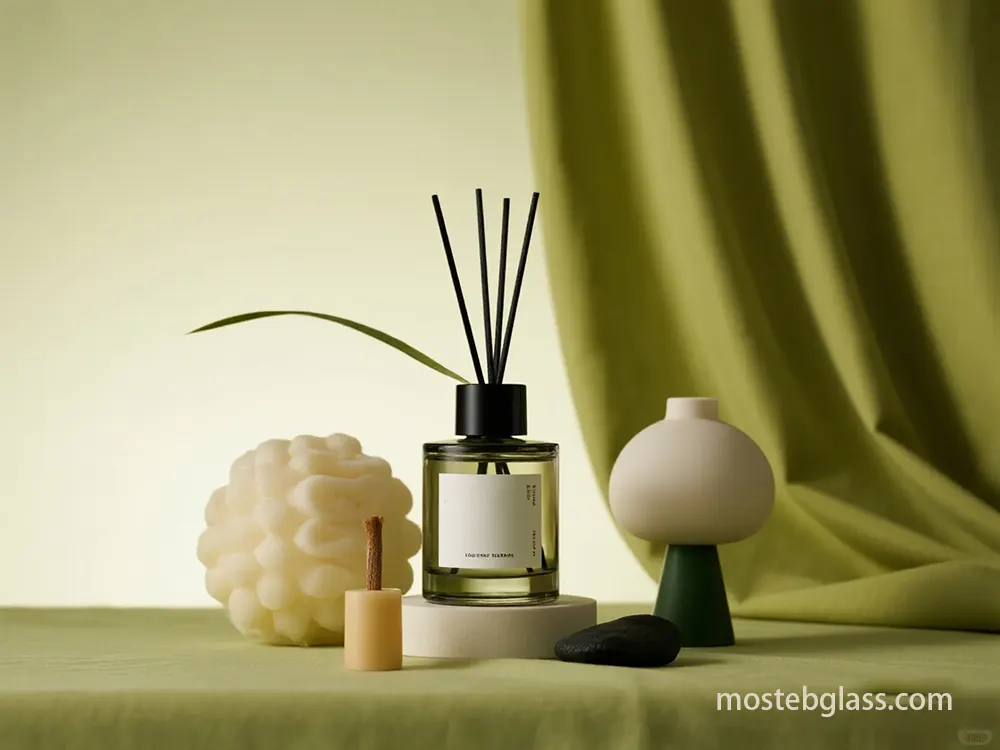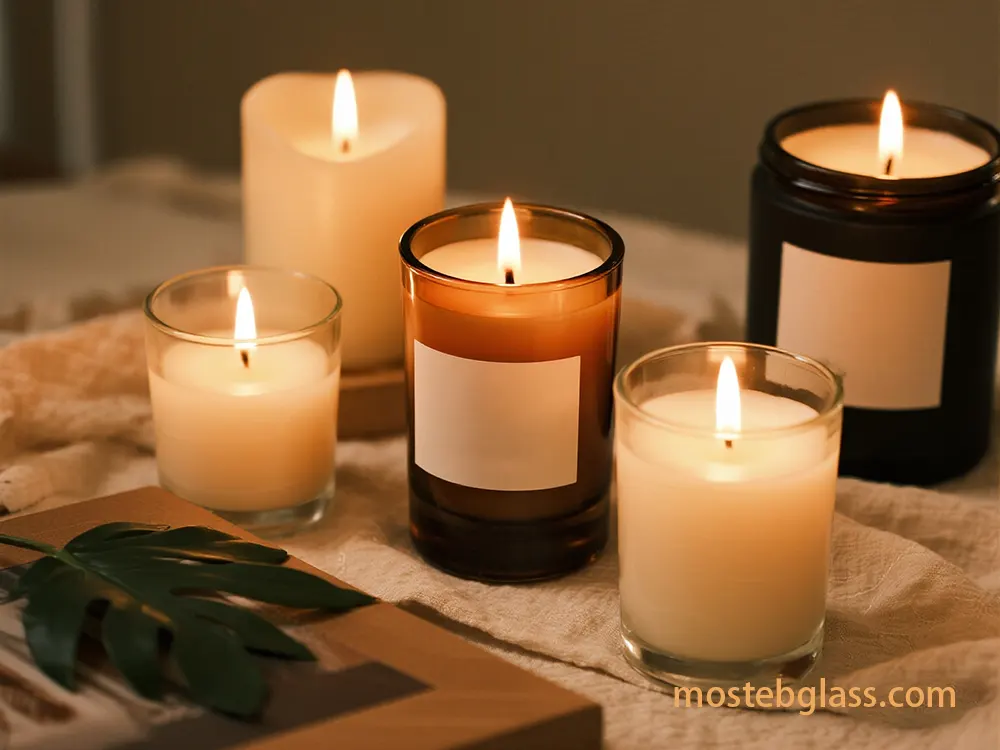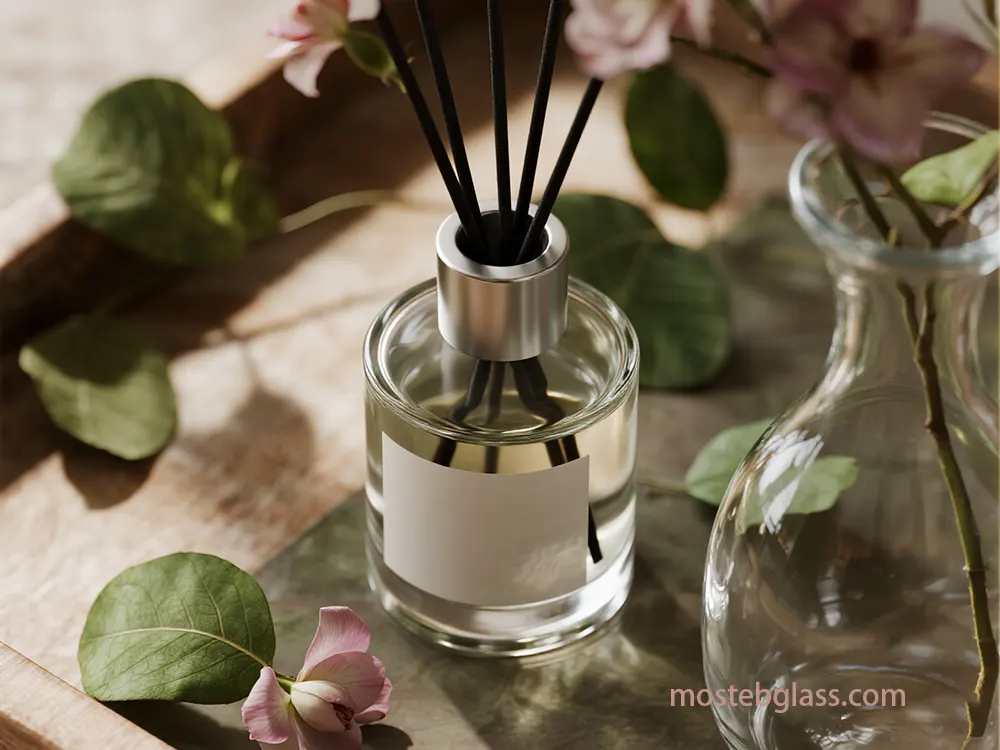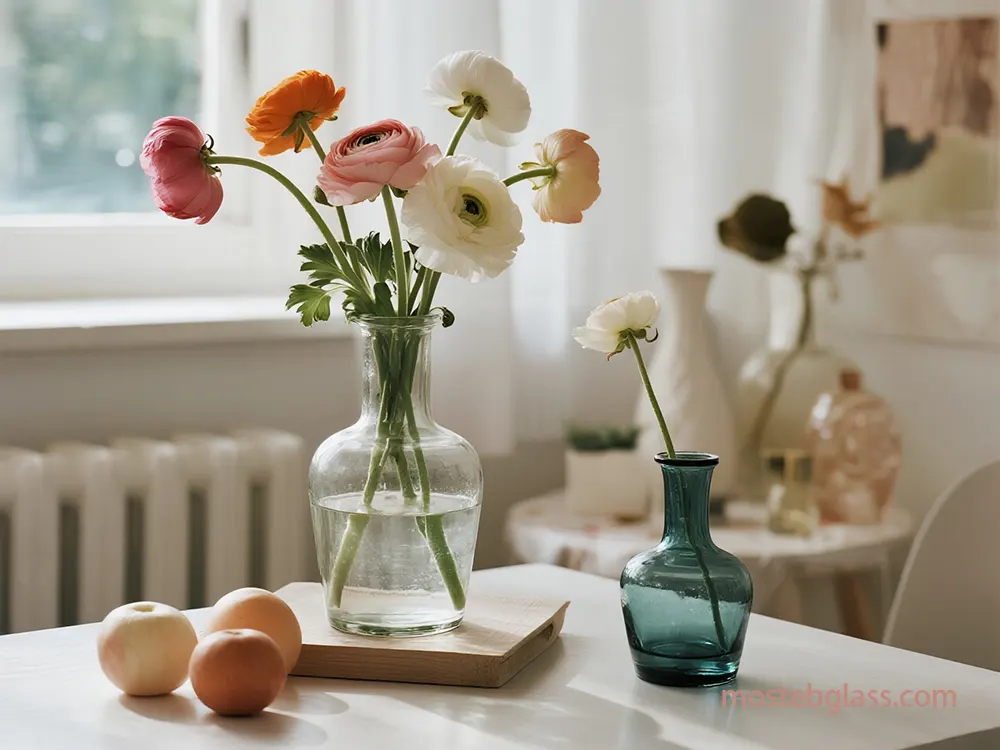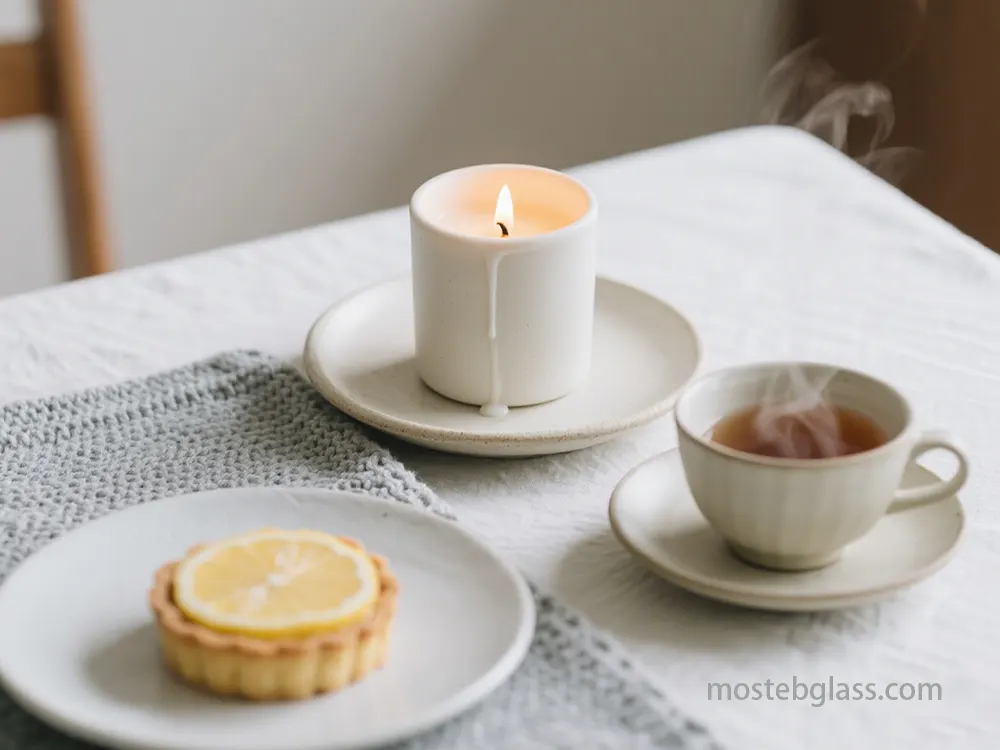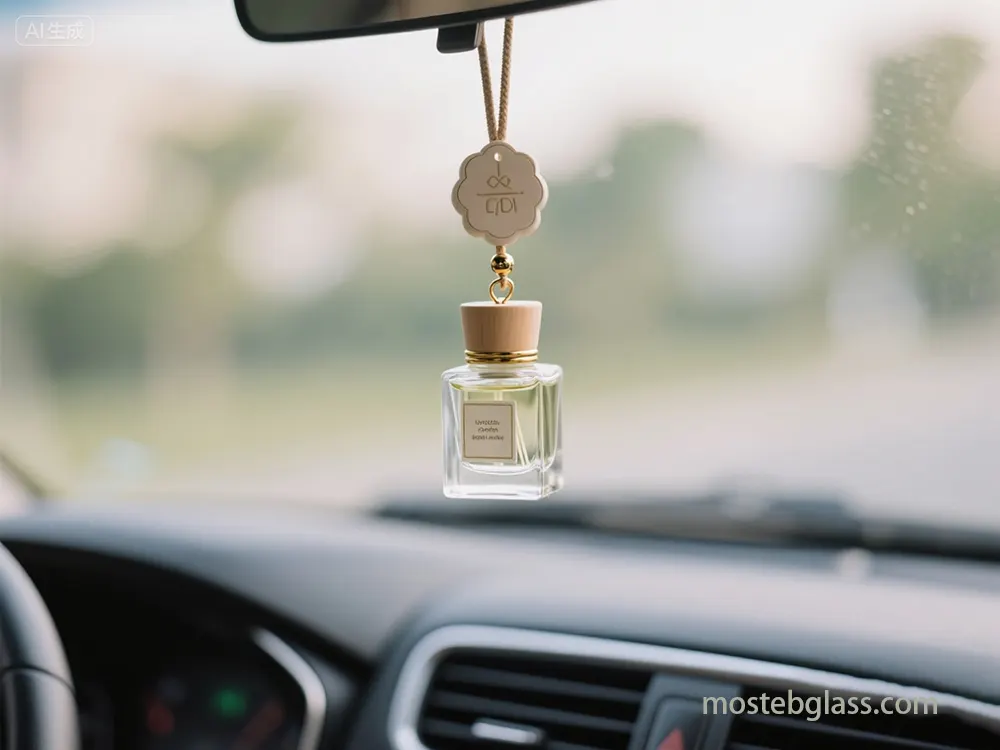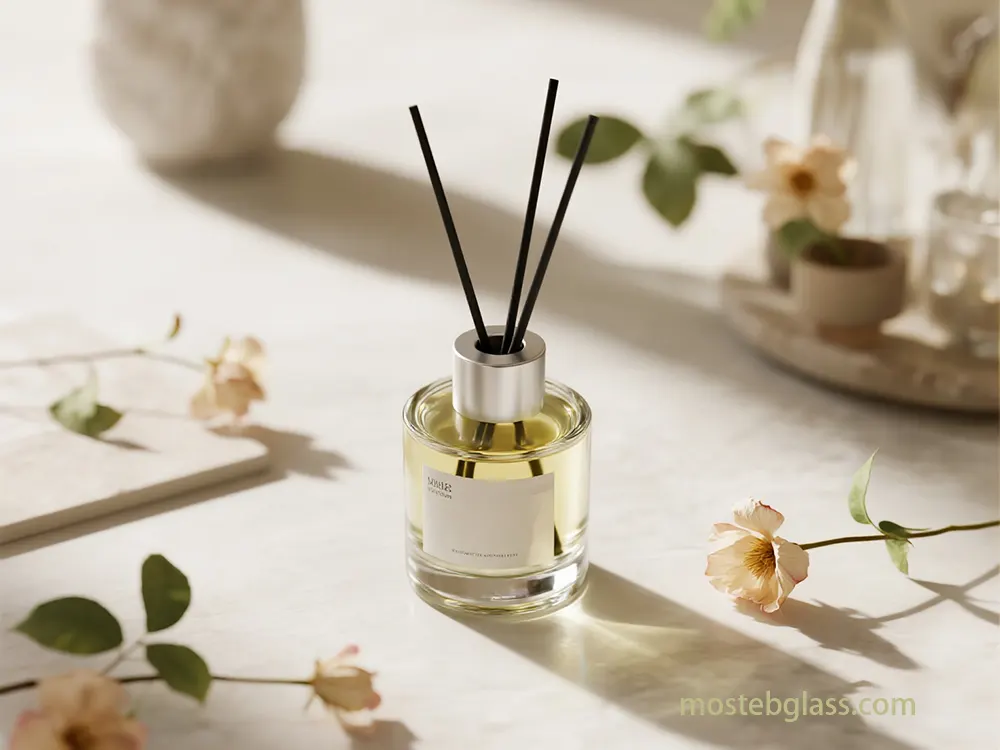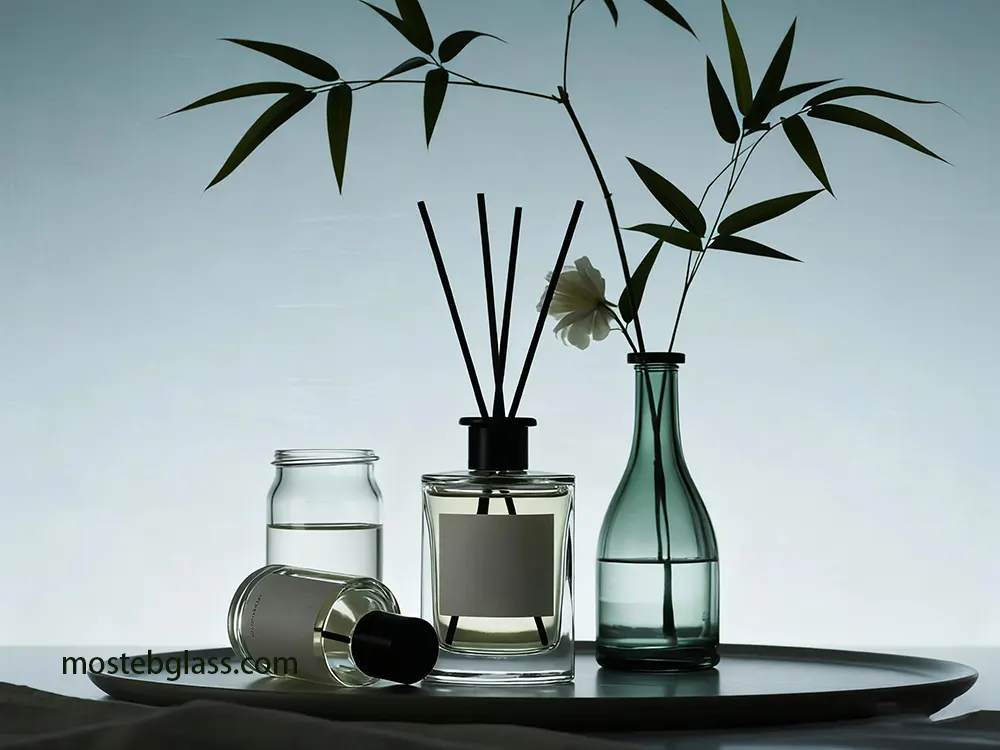The home fragrance industry, led by モステブ, a forward-thinking glass diffuser bottles vendor, is on the verge of massive change driven by consumers’ demand for more fashionable, eco-friendly, and high-tech products. Those who sell glass diffuser bottles are the most visible innovators in this field, with advancements in materials, design, manufacturing, marketing, and sustainability shaping the future of fragrance packaging.
1. How a Glass Diffuser Bottles Vendor Shapes Market Trends
The worldwide home fragrance market is going through a fast and strong growth with the market value expected to hit $40.55 billion by 2032. This growth is very much driven by the ongoing innovation and the strong wish of the consumers to get natural multi-sensory products which can improve their living spaces. The market players are favoring glass packaging due to its natural premium touch, good preservation properties, gentle eco-friendliness, and also unlimited recyclability which altogether are the main reasons why it still holds the largest market share. What is more, the exponential rise in e-commerce really pushes the need for the creation of handy, eco-friendly, and nice-looking custom packaging solutions. Such tailor-made packaging is not just a container; it is very important for building a strong brand identity, creating a deep consumer loyalty, and thus social media engagement which is increased considerably via the use of influencer marketing campaigns which show product aesthetics and values.
2. Breakthroughs in Glass Material Science and Design
Innovations in glass material science and design are never-ending and are not only making diffuser bottles more attractive but are also improving their functional performance, hence expanding their possibilities.
2.1. Novel Glass Formulations for Enhanced Sustainability and Performance
One of the major moves is the development of environmentally friendly glass compositions. “LionGlass”, a revolutionary product from Penn State is a perfect illustration of a glass that can be melted at much lower temperatures, thereby reducing the carbon emissions of its production process by half, so it is more environmentally friendly. Besides being kind to the planet, LionGlass is a ten times more crack-resistant glass, thus making it ultralight bottles with the same strength possible. More than that, the use of post-consumer recycled (PCR) materials is a great concern of the industry, which has been the main reason for the top producers who are now incorporating between 20 and over 70% of PCR glass in their luxury packaging lines to lead the way. This enables them to uphold the quality and aesthetic expectations of their customers and at the same time lower the weight and carbon footprint of the end product.
2.2. Advanced Coatings and Surface Treatments for Aesthetics and Durability
The new generation of glass coating and surface treating technologies is opening up a vast range of possibilities for glass finish designs from deep and velvety matte and super bright glossy to highly trend metallic and more. What is more, these coatings also significantly increase the glass durability, providing the product with stronger protection against chemical degradations, scratching, and harmful UV rays. Tactile endeavours like the exquisite “Soft Touch” and the visually attractive “Hi Rise” textures are made especially to reach the consumers via their senses. The utilization of these covers dramatically affects the consumers’ awareness and buying decision, as big part of the consumers attuned to pay more for the products that are finished with these unique and attractive ones according to the researches.
2.3. Challenges and Considerations
Regardless of these feats, glass packaging is still hammered by the problems, which are naturally embedded in this material, that arise from its higher priced first run as compared to some alternative materials, its suffering from being breakable which results in expensive double packaging, and its holding a bigger carbon footprint at production (although the latter is being significantly contradicted by the infinite recyclability factor). Furthermore, worries about microplastic contamination due to non-glass made parts like pumps or caps and the existence of per- and polyfluoroalkyl substances (PFAS) in certain resistant coatings that are getting more and more difficult to handle from both the environment and the health side are additional issues the industry is dealing with.
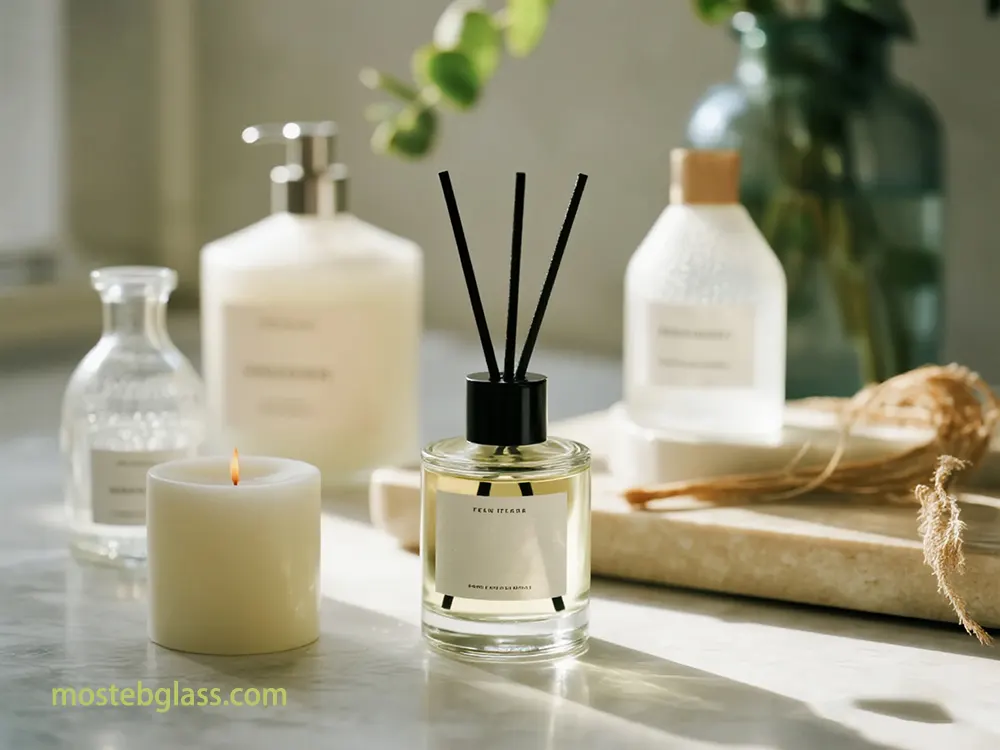
3. Functional Enhancements and Smart Integration in Diffuser Bottles
Leading vendors are actively integrating a range of functional improvements and smart features into their home fragrance products to significantly enhance the user experience and extend product longevity.
3.1. How Glass Diffuser Bottles Vendors Innovate Diverse Diffusion Mechanisms and Anti-Spill Designs
The most advanced smart diffusers are no longer limited to the traditional reed diffusion but have diversified their technological solutions extensively. Besides, next-generation units may also come equipped with innovative dry fragrancing technologies, cold air diffusion, ultrasonic misting, precisely waterless atomization, and highly efficient liquid-to-gas conversion techniques. Every single device has somewhat different implications for both the effectiveness of the scent and the total area that can be covered. Meanwhile, the integration of anti-spill systems into designs has progressed substantially, thus providing not only more comfort and safety for the users but also less worry over liquid containment especially in portable or dry fragrancing systems.
3.2. Modular Components and Proprietary Refill Systems
Many smart diffusers have lately embraced the idea of integrating modular refill components which can also affect the user’s preferences and recurring expenses. Some of the outstanding cases are the smart fragrance vials of Pura designed with unique features; the elegant glass bottles of Scentee Machina; and the creative scent capsules of Moodo. The usage of such methods guarantees not only compatibility but also that the brand offers a limited and selected range of the scent products, thus maintaining a uniform brand experience and also facilitating the buying of original refills.
3.3. Advanced Smart Features and IoT Integration
The integration of Smart diffusers with Internet of Things (IoT) platforms is extensive and it is letting the users have total control over the device and customize it in any way they want. The major functions are in most cases installation-controlled adjustment of the intensity, individual scheduling, easy remote operation, as well as the possibility to blend or change various scents quickly. Also, it is becoming a norm for those who have a voice command system to be compatible with Amazon Alexa, Google Home, and Apple HomeKit thus enabling users to control it with no hands at all. Besides, an upcoming trend within this domain features AI-based selection of scented articles as algorithms could learn users’ favorite smells and suggest the one depending on the hours of the day or mood.
3.4. Technical Challenges and Cybersecurity Concerns
Although the idea of fully integrated smart glass bottles looks very attractive from the user side, in reality, the whole embedding process face serious difficulties and production costs make it hardly feasible for mass production of consumer-grade ガラス製ディフューザーボトル. Therefore, the electronic parts are generally found in the main device, which is the separate unit while the fragrance container remains just a simple glass. Besides that, the growth of interconnected smart devices also leads to significant issues related to cybersecurity and users’ privacy worries. They may suffer from unauthorized data collection, insecure encryption protocols, as well as other problems that come together with smart home monitoring. Furthermore, the example of physical safety issues such as removing magnets from certain diffuser models causing recalls shows that at the same time as performance for electronic and mechanical parts, thorough test and design processes for safety are equally indispensable.
4. Optimizing Production and Supply Chains for Innovative Packaging
The transformation of home fragrance packaging, especially with innovative glass designs, calls for perpetual upgrading of manufacturing processes and highly sophisticated supply chain logistics.
4.1. Advancements in Automation
The glass manufacturing sector is fast to implement state-of-the-art AI-driven systems for real-time quality control and very precise defect detection. These technologies majorly elevate product uniformity, less wastage, and increase overall effectiveness. Across various production stages, the use of automation is substantially increased. For instance, not only can robotic systems be used for accurate case packing and fast palletizing but also for specialized operations like mold swabbing that help to achieve higher operational efficiency levels and maintain product quality at the same standard.
4.2. Lean Manufacturing Principles
Lean manufacturing principles are intimately followed to lessen the production cycle’s waste and at the same time increase output considerably. This includes process improvement without interruption, constant checking of Key Performance Indicators (KPIs), and employing such methods as Single-Minute Exchange of Die (SMED) that helps in substantially reducing the time for changeover. Besides this, the gradual transition to smaller batch productions gives more freedom in work, shortens the time between orders, and better manages expenses.
4.3. Strategies for High-Mix, Low-Volume Customization
High-mix, low-volume (HMLV) production methods are crucially important due to the increase in the demand for highly personalized products that come in small quantities, thus, niche markets and individually tailored products are effectively supplied. Automation along with collaborative robots (cobots) play the leading role in HMLV as they are the means through which accounts operate at minimal expenses while concurrently enhancing order processing, reducing the risk of stock, and allowing for extremely fast turnarounds of bespoke designs.
4.4. Regional Sourcing Strategies
The establishment of strong regional supply ecosystems, which can be seen clearly in Asia, is a strategic move designed to bolster local demand, lessen transport emissions, and provide quicker time-to-market.Implementing this local strategy goes a long way in solving the problem of constant cost pressures and supply chain resilience which is achieved through lessening the dependency on faraway global networks.
4.5. Impact of AI/ML on Predictive Maintenance and Supply Chain Transparency
AI and machine learning are completely changing the way companies run efficiently by helping them to foresee equipment breakdowns through predictive maintenance thus, lowering the expensive downtimes and making it easier to plan production schedules. On top of that, AI and machine learning are also good at pinpointing inefficiencies in the supply chain and making demand forecasts more accurate. At the same time, blockchain technology is making it easier to keep records that are transparent and cannot be changed throughout the entire supply chain. This is an effective way to fight against counterfeiting, assure product authenticity, and keep a detailed record of material lifecycles for better sustainability reporting.
4.6. Challenges of Scaling Bespoke Glass Designs
There are a lot of challenges that come up when one tries to scale up bespoke glass designs from just an idea to mass production, and those challenges usually include long lead times for custom molds, the fabric-like nature of the complex shapes, and the most important thing is very strict quality control at every stage. Nevertheless, one of the biggest benefits of custom glass is the almost endless design options it offers which can be really helpful for a brand to express itself in a completely unique way. Many companies in the glass industry are turning to digital technologies such as Building Information Modeling (BIM) and AI to juggle the tasks of design and production, thus, making custom glass not only easier to reach but also more efficient.
5. Market Segmentation and Vendor Strategies
The home fragrance market is witnessing the vendor strategies that differ widely in the way vendors approach the market, and the differentiation is more and more being achieved through the innovation and the thoughtful designing of the packagings.
5.1. Luxury Brands Integrating Sustainability with Heritage
According to the reports, upscale luxurious brands are gradually switching to the use of eco-friendly package solutions like recycled linen paper or newly developed mushroom mycelium materials, but at the same time, they are, by all means, preserving their brand heritage and stylish look. This considerable change of their strategy is a direct answer to the consumer’s demand for “luxury without guilt.” To further catalyze the industry’s transition to more sustainable practices, some considerable luxury players are already going beyond individual initiatives and entering collaborative pacts to exchange insights and innovations about sustainable materials.
5.2. Rise of Clean Fragrance Lines and Refillable Formats
The demand for ‘clean fragrance’ lines which do not contain parabens, phthalates, and are free from synthetic dyes, thereby attracting health-conscious consumers has been very significant and the trend is constantly growing. Meanwhile, refillable systems are being introduced rapidly as a new feature that will become standard in the luxury fragrance sector and is a move to which leading brands, among others, Mugler, Dior, and Chanel, have already committed. The extensive implementation of such measures points to the brands’ strong determination to be eco-friendly and it is also a way to provide customers with a green alternative to single-use packaging which is in line with the brand’s values.
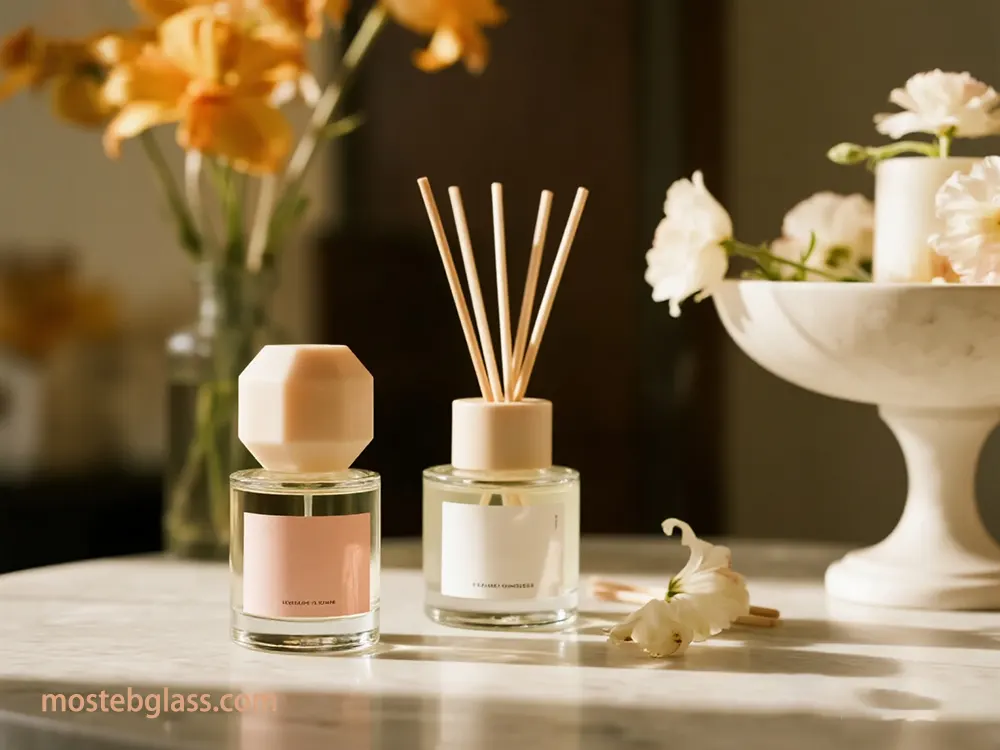
5.3. Packaging as a Primary Influencer and Psychological Impact
Packaging design is an extremely influential factor when deciding which product to buy. Talking about numbers, the impact of packaging design on consumer’s choices can be as high as 72%, according to research. The very first contact with a brand takes place in a snap of an eye, or, in other words, the brand’s silent salesperson, which is the packaging, is already there doing its job. And all this without saying a word, the packaging effectively uses the psychological tactics that are based on the color, the shape, the material, and the typography, to invoke desired feelings and perceptions in customers. On top of that, there are numerous emotional and unforgettable “unboxing experiences” that help the consumers to establish a strong emotional bond with the brand, get loyalty from them, and, on top of that, make social media sharing, thus giving the entire process the status of an event and not just a purchase.
5.4. E-commerce, Digital Channels, and Influencer Marketing
The home fragrance online sector market is in a state of burst and the brands have decided to energetically make use of digital marketing strategies, social media channels, and influencer marketing to address the situation. One of the ways to get to the customers is through TikTok Shop that has been turning into a vital channel for the purpose of consumer engagement, brand outreach, and direct sales generation all through the result of the authentic content creation and endorsements.
5.5. "Quiet Luxury" and Customization Trends
“Quiet luxury” trend is a kind of luxury that is characterized by the absence of loud branding, instead, it offers the buyers the feeling of refined luxury, consistent quality, and timeless pieces. This notion has a strong appeal to a certain kind of consumers, those with good taste and who appreciate the art of subtle sophistication. The market of the unique and personalized scents is simultaneously pushing the innovations in the area of the products as well as the packing materials, this includes the perfumery of customized and limited-edition collections as well. The global cosmetics and perfumery glass bottles market is flourishing, and this success is mostly attributed to the natural compatibility of these two sectors with the aesthetics of luxury and the objectives of sustainability.
6. Impact on Consumer Experience and Brand Value
One of the most important factors can be traced directly to the innovations in packaging home fragrance.
6.1. Sustainability as a Core Value and Premiumization Driver
In the first place, sustainability has not only gone beyond the community of its advocates and is now one of the major factors influencing the decisions of consumers and a key factor that distinguishes the company from its competitors. The consumers are ready to pay higher prices for products packed in environmentally friendly packaging as they become fully aware of the added value of responsible consumption.
6.2. The Power of Tactile and Visual Sensory Experiences
The outer covering of the product and the hand found are essential factors in raising the unforgettable experience with the product and including the memorable unboxing experience which is the main factor in brand loyalty and word of the mouth manifestation through social media, hence, the sharing of the product engagement once again.
6.3. Neuroscience and Emotional Connection
Of all the senses, smell is the one that has the most direct and powerful connection with emotion and memory, thus allowing brands to establish strong emotional ties with consumers. To decipher the latter, brands consult neuroscience research and facts as a source of inspiration for the creation of innovative design that can evoke emotions, regulate them, or turn ordinary personal moments into special brand occasions.
6.4. Consumer Willingness to Pay a Premium for Sustainable Attributes
Several pieces of research show the same thing over and over again, that is consumers will be more willing to pay higher prices for products which come with great sustainable packaging features The examples of such features include the use of glass, bio-based plastics, or recycled plastic content and the provision of refill options. This is unequivocal evidence of the financial benefits that serve as a strong business incentive for companies that aim to align their profits with the implementation of sustainable measures to ensure that eco-friendly packaging becomes their priority.
6.5. Mitigating Greenwashing Through Transparency and Authenticity
Initially, in order to win consumers’ trust and maintain it throughout the brand journey, companies are required to communicate their green initiatives not only with the utmost transparency but also with complete authenticity on the part of their brand. This includes providing explicit carbon transparency, sharing sustainability stories via storytelling, and using easily recognizable eco-friendly materials. In addition to that, the formation of industry-wide pacts as well as collaborations between organizations is not only helping to ensure that positive changes actually occur but is also playing a crucial role in thus preventing the misleading greenwashing claims.
6.6. Digital Engagement and Minimalist Design
The use of the Internet and social networks is of crucial importance nowadays for both presenting novel packaging concepts and sharing the leading ideas of the brand.
Social media campaigns, interactive websites, and QR codes on the packaging are just a few of the features that help create open communication lines between buyers and sellers. They also offer consumers detailed product information together with sustainability credentials. Besides this, the minimalist style, being one of the major visual trends, is generally considered a characteristic of either premium or “clean” products. The said appearance is in total harmony with the consumers’ increasing concentration on full health, wellness, and their urge for simplicity and straightforwardness in purchasing decisions.
7. Sustainability as a Core Driver of Transformation
Home fragrance packaging, propelled by ongoing breakthroughs in material science and production innovations, is being completely changed by sustainability measures. It is moving towards a more circular future.
7.1. Circular Economy Principles and Refill-Reuse Models
One of the key moves the fragrance industry is making towards sustainability is the incorporation of circular economy principles, mostly focusing on refillable packaging and reuse models. Big names in the market are now providing stylish refillable glass bottles or setting up locations where you can refill your containers right in the store, thus facilitating the consumers’ involvement in a closed-loop system. The final aim is glass closed-loop recycling, which is made possible by collaborative industrial efforts such as “Close the Glass Loop” and diverse programs that are specially designed for recycling difficult-to-recycle materials in a way that is most resourceful.
7.2. Life Cycle Assessments (LCAs) and Material Impact
On top of being lauded as a completely recyclable material, glass when evaluated through detailed Life Cycle Assessments (LCAs), is found to have an unavoidable heavy weight which can lead to a higher environmental impact of transportation in comparison to lighter substitutes such as PET. It is also worth pointing out that the primary glass production is an unfriendly-to-the-environment-and-energy-consuming process. Nonetheless, the very considerable energy reductions (up to 30%) and quite large carbon dioxide emission reductions that are obtainable when glass is recycled (using cullet) clearly highlight the long-term positive effects on the environment of this material when integrated into a closed-loop system properly.
7.3. Demand for Eco-Friendly Materials and Processes
The necessity that consumers put on eco-friendly products is a strong market driver, which shapes the trends that will be followed in packaging in the future. Among the trends that are forecasted for 2025 are: the extensive implementation of refillable systems, the amplified use of natural and bio-based materials, the evolution of mono-material designs for effortless recycling, the continuous choosing of minimalist aesthetics, and the increasing focus on carbon disclosure throughout the product’s lifecycle.

7.4. Corporate Sustainability and Certifications
Enterprises are proactively evidencing their unwavering pledges towards the eco-friendliness of glass by undertaking numerous actions which include, for example, the attainment of well-known awards like Cradle to Cradle PLATINUM certification. Besides having a good time in the limelight, they are energizing the whole industry by joining forces with other players taking part in the beauty sector such as Cosmetics Europe partnering up with “Close the Glass Loop.” Furthermore, these companies are executing far-reaching corporate programs aimed at giving back to nature by, among other things, realizing net-zero packaging goals, which is a resounding sign of their firm belief in the necessity of protecting the environment.
7.5. Challenges in Recycling Small Glass Items
One of the major obstacles on the way to the total circular use of glass is how hard it is to get small glass items for recycling. Examples are perfume and ディフューザーボトル, which are not easy to find and separate from other trash due to consumer confusion about recycling guidelines. Consumers unavoidably need to separate non-recyclable parts such as plastic pumps or metal collars which may be mixed with the rest of the packaging. At the same time, single-stream recycling systems that are available in most places do not help this cause as they are more prone to contamination, thus making it even more difficult to get high-quality glass cullet from the recycled materials.
7.6. Energy Consumption and Emissions of Glass Recycling
One of the main reasons for the general push to recycle glass is that that recycling, most notably through the use of cullet (the term used for the glass that has been collected and processed into uniform small pieces), leads to a significant reduction in the demand for virgin raw materials and brings down the melting point required for the production. This would allow the huge energy consumption in the production to be brought down by as much as 30% with the resulting decrease in CO2 emissions. Glass furnaces though are still very heavy users of energy even if they are in operation non-stop. Moreover, the gains from recycling can be somewhat neutralized by the energy and emissions related to the long-distance transport of the cullet or finished products.
7.7. Potential for Bio-based or Biodegradable Coatings on Glass
There are a lot of interesting and promising developments being made in the area of sustainable packaging, particularly in bioplastics and highly functional bio-based barrier coatings, that have been specifically made to extend shelf life and lower environmental impact. Research made in the field of polysaccharide film technology and completely new bio-based acrylates gives grounds for thinking that in the future quite a lot of new high-performance and ultimately biodegradable coatings for glass might be developed. These coatings may bring out some new side like better barrier properties or decorative effects, meanwhile, they would allow the package to be an eco-friendly one at its end of-life.
8. Future Trajectories: Emerging Technologies and Market Shifts
Based on the technologies that are emerging and big market changes that are happening, one can expect that in the near future glass diffuser packaging will not only be radically changed but also a whole new era of innovations will be opened in the field.
8.1. Advanced Material Composites for Ultra-Lightweighting and Enhanced Functionality
The packaging industry has set sights on advanced polymer composite materials with the goal of achieving ultra-lightweight as well as gaining new functional features. Bioplastics, like plant-based PEF (polyethylene furanoate) and cellulose-based materials, are turning out to be the most favorable substitutes for PET that not only provide better barrier properties but also drastically lessen carbon footprints. In the meantime, the use of nano-material in packaging is being explored for the possibilities it has in yielding extremely thin, strong, and even intelligent packaging with new kinds of properties.
8.2. Hyper-Personalization: AI-driven Scent Recommendations and Customization
One of the main points of Artificial Intelligence (AI) in the near future is to hasten the process of creating fragrances and at the same time to make them more personalized to an extreme degree. AI-driven platforms are utilizing complex algorithms, in most cases, they are supported by user quizzes and even biometric information, in order to manufacture unique scents that meet the tastes of a certain individual in the most exact way. This innovation in technology drastically cuts down both the development time and the expenses of the traditional way. Nevertheless, this trend provokes a number of ethical issues concerning the privacy of data, the safe management of private information, and the requirement of explicit permission by the consumer for using his data.
8.3. Integration of Augmented Reality (AR) for Interactive Packaging Experiences
With the aid of Augmented Reality (AR), consumers can be offered an interactive as well as a deeply engaging experience that the stores are increasingly making use of. AR’s functionalities extend from virtual try-on and product information overlays at a store to brand storytelling and also logistical tracking. Spatial computing is a major trend that will be instrumental in furthering these experiences. However, the extensive use of AR is still being confronted with problems of infrastructure development, raising consumer awareness, and the presence of uncertain regulatory issues that need to be solved first.
8.4. Futurist Reports, Tech Conference Summaries, and Venture Capital Investment Trends
One of the main points that packing conferences put across most of the time is the consideration of sustainability, reducing the carbon footprint, and the principles of the circular economy as their central themes. Reports of futurists depict a future in which technology will play a vital role in the development of packaging by bringing advanced AI, complex automation, and digital tools for smart designs and optimized production processes, etc. At the same time, there is a notable increase in venture capital investment in areas such as AI, Green Tech, and sustainable consumer products, which is a clear indication of strong financial support for innovative, eco-friendly, and smart packaging solutions that are in line with these future-oriented trends.
8.5. Potential for Self-assembling or Self-disassembling Packaging Materials (Speculative)
The main idea behind the circular economy is moving towards the goal of having no waste at all, where products are designed in such a way that they can either be easily disassembled for recycling or biodegrade without causing any harm. Even though the concept of direct “self-assembling” or “self-disassembling” materials is mostly speculative and theoretical at present, the rigorous emphasis on eco-design, the invention of sophisticated biodegradable materials, and the building of solid closed-loop systems are all measures leading to this destination. AI may be able to assist in equipping materials with a programmed end-of-life that makes it easy for them to be integrated into recycling or composting streams. This idea is also promoted by the implementation of Extended Producer Responsibility (EPR) systems and collaborative value chain partnerships that seek to guarantee the management of packaging materials in a responsible manner throughout their entire lifespan.
